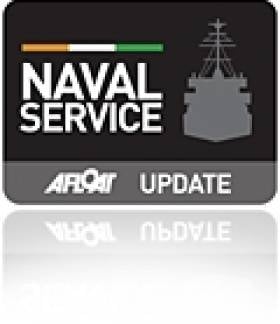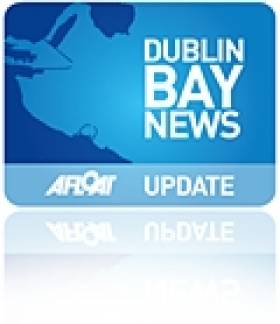Displaying items by tag: Maritime Institute of Ireland
New Lease of Life for Reopened Maritime Museum
#MARITIME MUSEUM REOPENING – It is good to report positive news, particularly the much awaited reopening of the Maritime Institute of Ireland's maritime museum in Dun Laoghaire, which is to take place today, writes Jehan Ashmore.
Since 2006, the museum secured vital Government grants to undertake repair, renovation and improvement works of the former Church of Ireland church built in 1837 which could accommodate up to 1,400 people. Due to dwindling parish numbers the church closed on Easter Sunday 1972 and two years later the museum moved in.
Over the next three decades visitors enjoyed the unique and apt setting of the former Mariners Church. However as the years rolled the structure of the building was in need of urgent attention which led to the closure in 2004.
The extensive work has included the replacement of the roof, treatment of dry rot, repointing and cleaning of the stonework, replaced plasterwork, repair of the stained glass windows, installation of new lighting and heating systems and wheelchair accessibility provided.
Initially the museum will only use the ground floor, having said that a new layout is presented with several 'stories' centred around these exhibits, to read more about the exhibits click HERE.
In addition children will be entertained by a Knot Station and there is to be a souvenir shop and coffee dock. Opening hours are 11am to 5pm Tuesday to Sunday, including Bank Holidays, for further information visit: www.mariner.ie
The Maritime Institute of Ireland celebrated its 70th anniversary last year, and was established primarily to highlight the importance of an Irish mercantile fleet, the role of ports and shipping, fishing and to recognise and foster our maritime heritage.
Members can join the Institute with the benefits of accessing the museum (covering admission) runs a lecture programme, issue newsletters, host and support commemorations and conducts research. As a voluntary organisation they also welcome new recruits.
The instiute's patron is President Michael D. Higgins who is to officially reopen the museum in early June.
Lecture: The East India Company in Kinsale
#LECTURE - This month's lecture organised by the Maritime Institute of Ireland (M.I.I.) is about 'The East India Company in Kinsale', presented by Paddy O'Sullivan.
The lecture will be held next Thursday (15th March) starting at 8pm and as usual takes place in the Stella Maris Seafarers Club on Beresford Place, close to Busaras and behind the Customs House.
O'Sullivan is an engineer, diver, author, and lecturer has uncovered a vast amount of information about the activities of the East India Company in Munster, regarding ship-building, trading, iron smelting, and cannon casting.
All are welcome to attend the evening where a bar and refreshments are available. A voluntary contribution is at the door. The organisers would be pleased for anyone to kindly forward details about the lecture programme, held monthly (third Thursday) at the city-centre venue.
Public transport: The nearest DART stations are Connolly Station and at Tara Street in addition to the LUAS (Red) line stop at Busáras. Car parking is located in the Irish Life Mall (ILAC) on Lower Abbey Street. For information of the lecture programme call 086 150 3766 and by visiting www.mariner.ie/lectures-spring-2012
Homage Paid to Irish Founder of Argentinian Navy
#ADMIRAL BROWN- As Wexford is to host The John Barry Maritime Festival this summer, the father of the US Navy and commodore is held in the same league of Admiral William Brown, who founded the Argentinian Navy, who was remembered in a ceremony over the weekend in Buenos Aires, writes Jehan Ashmore.
The commemoration was to mark the 155th anniversary of William Brown's passing which took place at the Recoleta Cemetery, which was headed by Vice Admiral Carlos Alberto Paz, Chief of Staff of the Argentine Navy.
Among those attending were the Irish Ambassador, Mr. James McIntyre, the Chairman of the National Brownian Institute, Prof. Emilia Menotti, the President of the Naval Club, Vice Admiral Eduardo R. Llambi (Ret.) and City Council Officials.
The Navy General Directorate for Education marching band was also present, as well as Officer Cadets from the Admiral Brown Naval Lyceum (Reserve Officers' Academy). The Irish flag was carried alongside the host country by officers of the HQ Security Marine Bn.
For more about the event which included Santiago L. Aversa who represented the Irish branch of the Maritime Institute of Ireland (click HERE) and where its maritime museum in Dun Laoghaire is due to reopen early next month as previously reported on Afloat.ie
In 2006 the Naval Service 'flagship' L.É. Eithne (whose adopted homeport is Dun Laoghaire) under the command of Commodore Mark Mellett, made a historic first for the Naval Service when visiting Argentina and other South American ports.
In the same year two identical statues of the admiral were unveiled, one in Dublin's Docklands at Admiral Brown Way and Westport, Co. Mayo where the admiral hailed from.
Admiral Brown won victories against the Spanish and Brazilian fleets and as such he is regarded as a national hero, where in excess of 1,000 streets, 400 statues and venues such as stadiums (including football teams) schools, several towns, and a major city bears his name.
- naval service
- Argentinian Navy
- L.E. Eithne
- Commodore John Barry
- Admiral William Brown
- Commodore Mark Mellett
- M.I.I.
- Maritime Institute of Ireland
- Mariners Church Dun Laoghaire
- Maritime Museum Dun Laoghaire
- Dublin Docklands
- The John Barry Maritime Festival
- Admiral Brown Way
- Irish Ambassador McIntyre
- Westport Co Mayo
- Wexford Town
Lecture: Building Dun Laoghaire Harbour
#LECTURE – This month's lecture organised by the Maritime Institute of Ireland (M.I.I.) is about 'Building Dun Laoghaire Harbour' and is to be presented by Colin Scudds.
The lecture next Thursday (16th February) starts at 8pm and as usual takes place in the Stella Maris Seafarers Club on Beresford Place, close to Busaras and behind the Customs House.
All are welcome to attend the evening where a bar and refreshments are available. A voluntary contribution is at the door. The organisers would be pleased for anyone to kindly forward details about the lecture programme, held monthly (third Thursday) at the city-centre venue.
Public transport: The nearest DART stations are Connolly Station and at Tara Street in addition to the LUAS (Red) line stop at Busáras. Car parking is located in the Irish Life Mall (ILAC) on Lower Abbey Street.
For further information and of the lecture programme, contact 086 150 3766 and visit www.mariner.ie/lectures
Screening Shown of Unique Lives Lost at Sea Ceremony
#MARINERS WITH MEMORIES – At the weekend representatives of the maritime community, relatives and visitors alike attended a screening of the 'Mariners with Memories' ceremony, which was shown in the Maritime Museum, Dun Laoghaire.
The ceremony which took place in Bray Harbour last July, is unique in that it recognises to all those lost to sea throughout the world and especially to those whose grave is the sea.
Shot by Colm Fynes, the film documented the day's proceedings with tributes made at the Co. Wicklow harbour and the flotilla that followed with floral tributes carried out close to the shore.
Captain Tony O'Grady who organised the Mariners with Memories ceremony, thanked all those to the museum and the support of the Maritime Institute of Ireland, whose newly renovated museum was a particularly apt venue, being the former Mariners Church.
Some of the relatives who attended the memorial event in Bray were also at the Dun Laoghaire screening and where they gave moving tributes to loved ones.
Commenting on the poignancy of the screening, Captain O'Grady referred to the on-going tragic events in Glandore Harbour and off the Italian island of Giglio.
He added that those involved in the various services off the West Cork fishing harbour would of liked to have attended but given the circumstances, all the resources were required at the scene.
It is hoped that following the inaugural ceremony, that Mariners with Memories will become an annually held event and the close relationship with the museum continues.
The museum which was especially opened for the screening will remain closed throughout the winter months though is open on an invitation only basis. Officially the museum is due to re-open this Easter, to keep posted of further developments visit www.mariner.ie
Fashion Extravaganza Evening and Lecture Maritime Morning
10 a.m. 'Dublin Port – Past and Present'– Niall Dardis
11 a.m. 'The Blood Red Badge: Dublin Dockers, Seamen and their Unionisation' – Francis Devine
12 Noon 'Liffey Ships' – Pat Sweeney
All are welcome to attend the lecture morning, noting the nearest DART station to the venue is at Pearse Street. For further information about other events, activities and developments of the M.I.I. visit www.mariner.ie
T.D.’s to Strut their Stuff in aid of Maritime Museum
The fundraiser event which is in aid of the Development Fund of the museum, is to take place this Thursday evening (8 p.m.) on 10th November, in the National Yacht Club (NYC) along the waterfront of Dun Laoghaire Harbour, close to the East Pier.
Tickets costing €20 are available from the Maritime Institute of Ireland's (M.I.I.) museum office located on the top floor of the Dun Laoghaire Shopping Centre, in local fashion shops and by contacting (01) 214 3964.
At the end of last month, the M.I.I. celebrated its 70th anniversary which was founded in 1941. To read more about the museum which is undergoing renovation and due to re-open in March 2012 click HERE and to read other news and developments visit www.mariner.ie
- National Yacht Club
- Dublin Bay News
- Maritime Institute of Ireland
- Dun Laoghaire Harbour
- M.I.I.
- Richard Boyd Barrett
- nyc
- Dun Laoghaire Harbour News
- National Maritime Museum
- East Pier Dun Laoghaire
- Irish Maritime Museum's
- Independent T.D's
- Luke 'Ming' Flanagan
- Mick Wallace
- Captain Roger's
- Irish T.D's
- Dun Laoghaire Shopping Centre
- Dun Laoghaire Waterfont
- Dublin Bay yacht clubs
Lecture: The Vasa-Fifty Years On
The lectures are usually held on the third Thursday of each month and mostly in Stella Maris. The club is located between the Irish Life Mall car park (ILAC), the Customs House and Busaras. It is convenient to the Luas (Busaras stop) and the Dart (Tara Street station). For more information on visit www.mariner.ie/lectures
Work In Progress in Dun Laoghaire Maritime Museum
Following the one-day soft-opening, any group which wishes to visit the museum by appointment should contact the MII's Tel: (01) 280 0969 or you can also call (01) 214 3934.
To read more about the renovation programme click HERE. If you would like to assist through voluntary work, fund-raising activities or make a donation in addition to keeping abreast of news, events and winter lecture programme visit www.mariner.ie
Dun Laoghaire’s Maritime Museum Set for Re-Opening
At the end of this month the M.I.I. will celebrate the 70th anniversary of its foundation and it is the intention of the voluntary run museum to 'officially' re-open in March 2012.
To read more about the renovation programme click HERE. If you would like to assist through voluntary work, fund-raising activities or make a donation in addition to keeping abreast of the latest developments visit www.mariner.ie
View Larger Map







































































